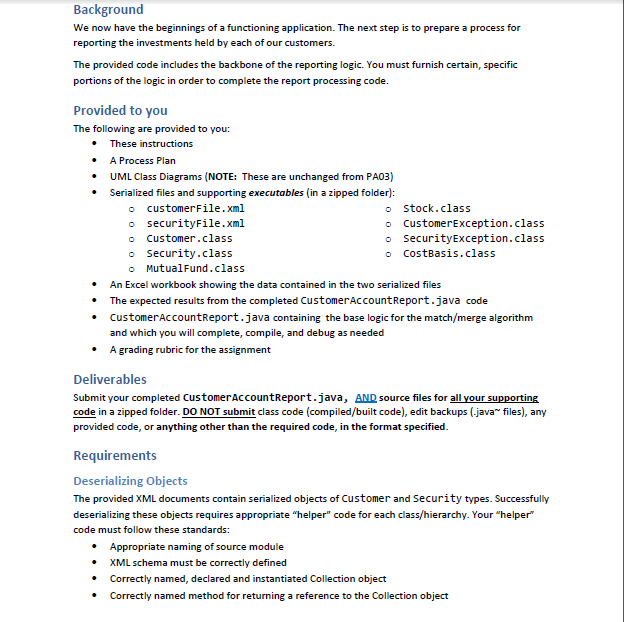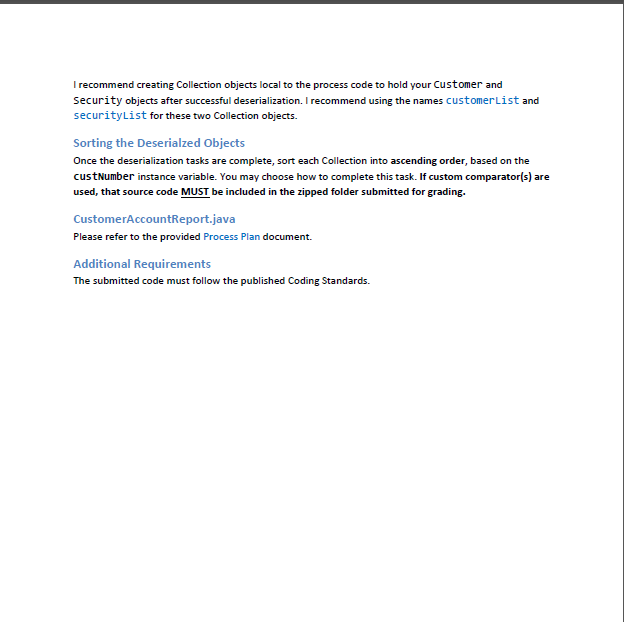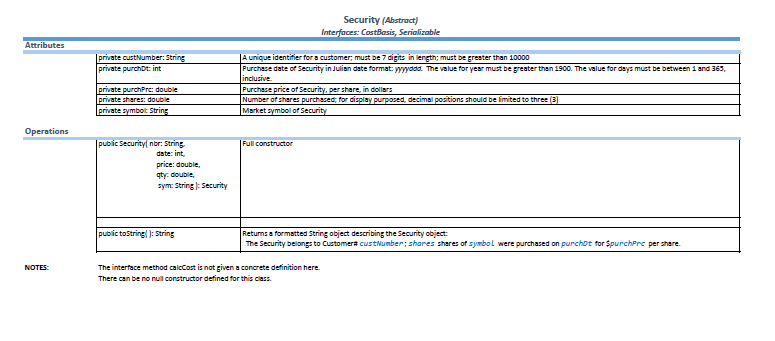[Solved]Background Beginnings Functioning Application Next Step Prepare Process Reporting Investme Q37215888
Can I get help making the comparator classes of these two?




Background We now have the beginnings of a functioning application. The next step is to prepare a process for reporting the investments held by each of our customers. The provided code includes the backbone of the reporting logic. You must furnish certain, specific portions of the logic in order to complete the report processing code. Provided to you The following are provided to you: These instructions A Process Plan UML Class Diagrams (NOTE: These are unchanged from PA03) Serialized files and supporting executables (in a zipped folder): e o customerFile.xml o Stock.class o CustomerException.class o SecurityException.class o CostBasis.class securityFile.xml o Customer.class o Security.class o MutualFund.class An Excel workbook showing the data contained in the two serialized files The expected results from the completed CustomerAccountReport.java code CustomerAccountReport.java containing the base logic for the match/merge algorithm and which you will complete, compile, a A grading rubric for the assignment as needed nd debug Deliverables Submit your completed CustomerAccountReport.java, AND source files for all your supporting code in a zipped folder. DO NOT submit class code (compiled/built code), edit backups (.java files), any provided code, or anything other than the required code, in the format specified Requirements Deserializing Objects The provided XML documents contain serialized objects of Customer and Security types. Successfully deserializing these objects requires appropriate “helper” code for each class/hierarchy. Your “helper” code must follow these standards: naming of source module XML schema must be correctly defined Correctly named, declared and instantiated Collection object Correctly named method for returning a reference to the Collection object * * I recommend creating Collection objects local to the process code to hold your Customer and Security objects after successful deserialization. I recommend using the names customerList and securityList for these two Collection objects. Sorting the Deserialzed Objects Once the deserialization tasks are complete, sort each Collection into ascending order, based on the custNumber instance variable. You may choose how to complete this task. If custom comparator(s) are used, that source code MUST be included in the zipped folder submitted for grading CustomerAccountReport.java Please refer to the provided Process Plan document. Additional Requirements The submitted code must follow the published Coding Standards Customer (Serializable) Attributes private custNumber: String A unique identifier for a customer, must be 7 digits in length; must be greater than 10000 tin: Strin number-TIN, EIN, or SSN; must be 9 dits lon private last String private first: String private margin: int r’s last name (or surname) as per legal identification; If冫value is offered, it must be neither null nor bank r’s first (or given) name as per legal indentifcation. If a value is offered, it must be null nor blank Margin limit for trading expressed as whole dollars; if equal to zero- customer is not for margin trading. Default value is zero. Negative values are not permitted private drip: boolean futures: boolean Indicates whether customer is authorized for futures contracts tradi public Customer nbr: String d: String Name: String, Name: String im: int, reUp boolean, Auth: boolean : Customer Returns a formatted String object with a verbose description of the Customer object Customer custNumber,first Last limit of Smargin The account carries a margin li The account will reinvest dividends as recieved. The account is authorized to trade in futures contracts Alternates for the last two lines will read “Dividends will be deposited as cash funds. (when drip falze) and “The account is not authorized to trade futures contracts.” (when sfalze public toString:String a formatted String object containing raw values of all instance variables: NOTE There can be no null constructor defined for this class Security (Abstract) Attributes A unique identifier for s customer; must be 7 digits in ength; must be grester than 10000 Purchase date of Security in Julian date format: yyoidd. The value for year must be grester than 1900. The value for deys must be between 1 and 363 priwate custNumber: String private purchDt int Full constructor nbr: String date: int qty doue aym:String Security pubic toStringl ):String Returns a formatted String object describing the Security object The Security belongsto Customer# custNumber: shares shares of symbol were purchased on purchot for SpurchPre per tere. The interface method caicCost is not given a concrete definition here. There can be no nul constructor detined for this cass. NOTES Show transcribed image text Background We now have the beginnings of a functioning application. The next step is to prepare a process for reporting the investments held by each of our customers. The provided code includes the backbone of the reporting logic. You must furnish certain, specific portions of the logic in order to complete the report processing code. Provided to you The following are provided to you: These instructions A Process Plan UML Class Diagrams (NOTE: These are unchanged from PA03) Serialized files and supporting executables (in a zipped folder): e o customerFile.xml o Stock.class o CustomerException.class o SecurityException.class o CostBasis.class securityFile.xml o Customer.class o Security.class o MutualFund.class An Excel workbook showing the data contained in the two serialized files The expected results from the completed CustomerAccountReport.java code CustomerAccountReport.java containing the base logic for the match/merge algorithm and which you will complete, compile, a A grading rubric for the assignment as needed nd debug Deliverables Submit your completed CustomerAccountReport.java, AND source files for all your supporting code in a zipped folder. DO NOT submit class code (compiled/built code), edit backups (.java files), any provided code, or anything other than the required code, in the format specified Requirements Deserializing Objects The provided XML documents contain serialized objects of Customer and Security types. Successfully deserializing these objects requires appropriate “helper” code for each class/hierarchy. Your “helper” code must follow these standards: naming of source module XML schema must be correctly defined Correctly named, declared and instantiated Collection object Correctly named method for returning a reference to the Collection object * *
I recommend creating Collection objects local to the process code to hold your Customer and Security objects after successful deserialization. I recommend using the names customerList and securityList for these two Collection objects. Sorting the Deserialzed Objects Once the deserialization tasks are complete, sort each Collection into ascending order, based on the custNumber instance variable. You may choose how to complete this task. If custom comparator(s) are used, that source code MUST be included in the zipped folder submitted for grading CustomerAccountReport.java Please refer to the provided Process Plan document. Additional Requirements The submitted code must follow the published Coding Standards
Customer (Serializable) Attributes private custNumber: String A unique identifier for a customer, must be 7 digits in length; must be greater than 10000 tin: Strin number-TIN, EIN, or SSN; must be 9 dits lon private last String private first: String private margin: int r’s last name (or surname) as per legal identification; If冫value is offered, it must be neither null nor bank r’s first (or given) name as per legal indentifcation. If a value is offered, it must be null nor blank Margin limit for trading expressed as whole dollars; if equal to zero- customer is not for margin trading. Default value is zero. Negative values are not permitted private drip: boolean futures: boolean Indicates whether customer is authorized for futures contracts tradi public Customer nbr: String d: String Name: String, Name: String im: int, reUp boolean, Auth: boolean : Customer Returns a formatted String object with a verbose description of the Customer object Customer custNumber,first Last limit of Smargin The account carries a margin li The account will reinvest dividends as recieved. The account is authorized to trade in futures contracts Alternates for the last two lines will read “Dividends will be deposited as cash funds. (when drip falze) and “The account is not authorized to trade futures contracts.” (when sfalze public toString:String a formatted String object containing raw values of all instance variables: NOTE There can be no null constructor defined for this class
Security (Abstract) Attributes A unique identifier for s customer; must be 7 digits in ength; must be grester than 10000 Purchase date of Security in Julian date format: yyoidd. The value for year must be grester than 1900. The value for deys must be between 1 and 363 priwate custNumber: String private purchDt int Full constructor nbr: String date: int qty doue aym:String Security pubic toStringl ):String Returns a formatted String object describing the Security object The Security belongsto Customer# custNumber: shares shares of symbol were purchased on purchot for SpurchPre per tere. The interface method caicCost is not given a concrete definition here. There can be no nul constructor detined for this cass. NOTES
Expert Answer
Answer to Background We now have the beginnings of a functioning application. The next step is to prepare a process for reporting … . . .
OR

